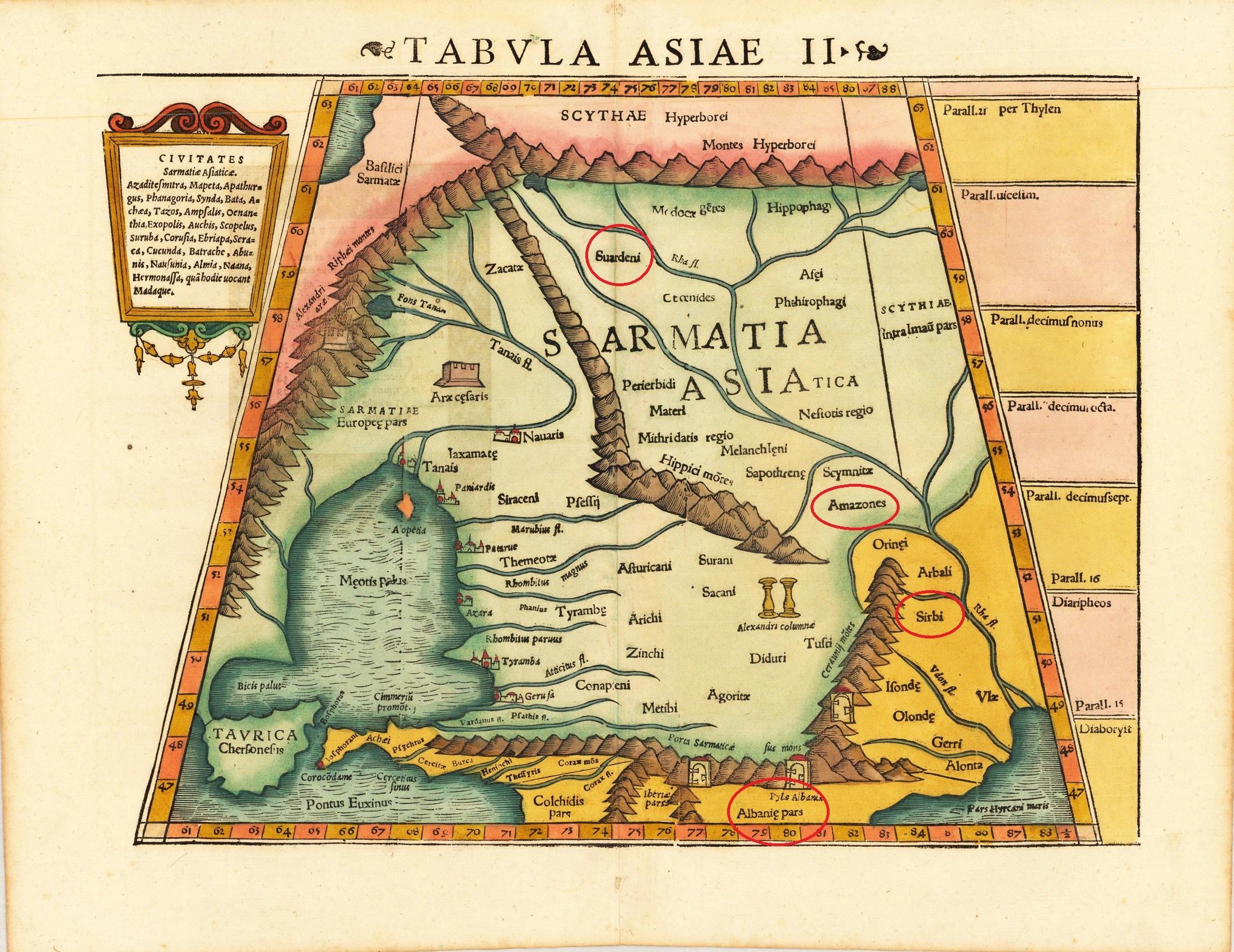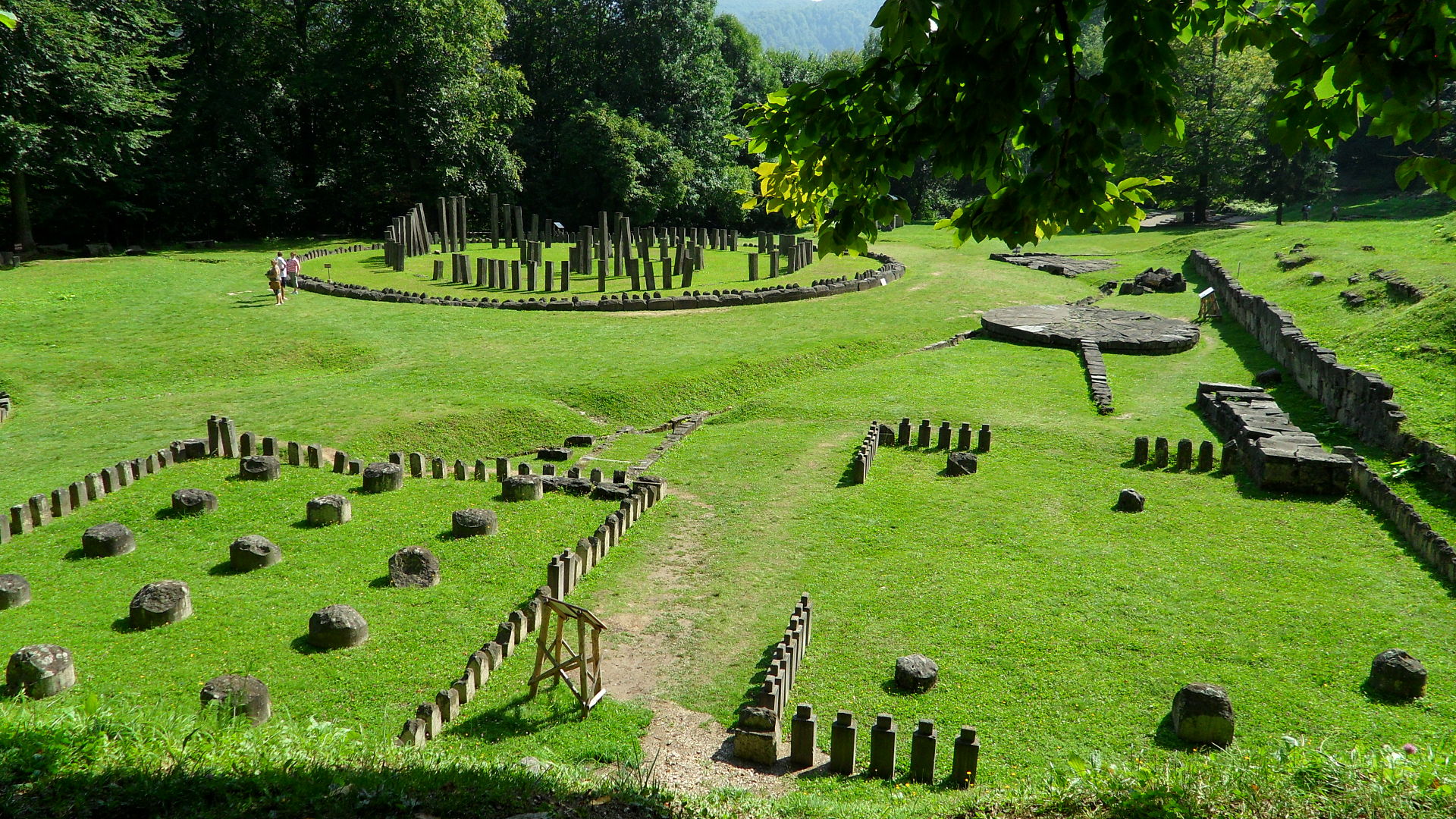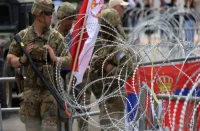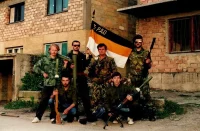Contemporary historiography and the Slavonic studies upon the question of the ethnolinguistic origin of the Croats and the Serbs more and more incline on the side of those authors who support the linguistic theory of the Indo-Sarmatian (the Iranian) origins of proto-Croats and proto-Serbs.
The Indo-European Iranian origin
According to this contemporary explanation, Croats and Serbs were the people of the Iranian (the Sarmatian) origin, who migrated into the Balkans in the 7th century and subjected the Slavs there. However, in the course of time, they became totally slavicized (like proto-Turkic Bulgars who were settled on the Balkans between the Danube River and the Balkan Range) but gave their own ethnic name to the Balkan Slavic subjects. At least from the beginning of the 9th century, both Croats and Serbs are clearly a Slavic people. For those authors, linguists proved that words Croat and Serb are not of the Slavic language at all. They believe that name Croat is similar to the Iranian-Sarmatian place name Choroathos, on the lower Don River, or that name Croat originated in the Iranian Chrovatosa, a prominent chieftain who gave his own personal name to the tribe (people) ruled by him.
Some scholars argue that the Iranian name Croat can be found as a personal name in the inscriptions from Tanais from the 2nd and 3rd centuries, or that words haurvatar means in the Iranian – “cattle-breeder”, and huurvatha – “friend”. In addition, there are two Greek inscriptions in the area of the Azov Sea around the mouth of the Don River related to the personal names – Horóathos and Horúathos, which are considered to be of the Iranian-Sarmatian origin. Around the time of Jesus Christ, there was the Iranian-Sarmatian tribe on the lower Don River that was known to the Greek geographers as Serboi. In the 10th century, one Arab geographer noted a Sarban tribe in the Caucasus. These two tribes are clearly not of the Slavic origin.

As a matter of fact, many ethnic Slavs have participated in the armies led by the Iranian-Sarmatian Croats and Serbs and have migrated to the Balkans with their Iranian-Sarmatian military leaders and lords. The sources are speaking in this matter about Indo-European Slaveni – a Slavic people living north of the Danube River in the 5th and 6th centuries which basically provided the crucial part of the manpower which occupied the Balkan Peninsula in the 6th and early 7th centuries (more precisely, from around 580 to 626, according to the Byzantine sources). Assimilation, i.e. Slavization, of the Iranian-Sarmatian Croats and Serbs started already beyond the Carpathian Mountains. The Iranian-Sarmatian Croats and Serbs have been relatively few in number, but as warrior horsemen, they became greatly superior over conquered Slavs. They came to the Balkans in the second wave of the Slavic settlement on the peninsula where they met and subjugated already settled Slavic tribes from the first wave of migration to the Balkans. The newcomers, led by the Iranian-Sarmatian Croats and Serbs, provided a general name for all Slavs under their sway, which are known today as the ethnic Croats and Serbs. In other words, since the Slavs were the vast majority, and as the Iranian-Sarmatian Croats and Serbs intermarried and mixed with them, in the course of time the conquerors came to speak Slavic too and ultimately the Slavic language they came to speak and which had been spoken by the earlier arriving Slavs (from the first migration) came to be named after the Iranian-Sarmatian newcomers (from the second migration to the Balkans). Finally, this process of assimilation was identical with that one of the Turkic Bulgars who conquered the Seven Slavic tribes on the territory of present-day North Bulgaria. They came to be slavicized in the course of time but provided the ethnic name for the Slavic people, language, and state established in Bulgaria. Those Seven Slavic Tribes have been a group of Slavic tribes who formed a kind of political confederation before the Turkic Bulgars crossed the Danube River in 671 (under the Khan Asparuh) and occupied them. However, the Slavic tribe Severi in present-day North Bulgaria succeeded even after the arrival of the Turkic Bulgars to maintain considerable sovereignty in the 8th century.
In general, the early medieval Serbs and Croats were a people of most probably Iranian ethnolinguistic origin, who migrated into what was the territory of ex-Yugoslavia at the turn of the 7th century and subjected the autochtonous Slavs settled there. In the course of time, they became slavicized but gave their ethnic names to the subjected Slavic people and its language. Both proto-Croats and proto-Serbs became at least from the 9th century, if not earlier, clearly a Slavic people. According to the Byzantine source of the Emperor Constantine VII Porphyrogenitus (913−959) De administrando imperio, the Balkan Croats arrived from the territory of White Croatia north of the Carpathians.

There is an opinion by many experts in the Slavic studies that ancient Sarmatians, Scythians, and Antes were the Slavs and, therefore, proto-Croats and proto-Serbs maybe parts of them. The Scythians were an Iranian people which dominated Central Asian steppes up to the Caucasus and the Danube River during the first millennium B.C. The Sarmatians also have been an Iranian people originating in Central Asian steppes but settled in the territory north of the Danube River in the 3rd−5th centuries. The Antes were an ancient Iranian tribe but in the course of time came into contact with the Byzantine Empire by absorbing the Slavs and, therefore, became the Slavic speaking population. They came from Central Asian steppes in the 5th century occupying the territories of present-day East Romania and Moldova (Bessarabia). In addition, most probably that ancient Balkan Illyrians of the Indo-European origin, dominating the Central and West Balkans, have been, in fact, autochtonous Slavs (but not Albanians) of South-East Europe. They became conquered by Rome before the Slavic (Croat and Serb) second migration.
The Turkic peoples at South-East Europe
The Turkic peoples have been a linguistic group of people originating in Central Asia whose majority swept across Central Asian steppes. Some of them migrated as far as the present-day Great Hungarian Plain (Hungarians or Magyars). They had historically a great influence on the Balkan Serbs and Croats as raiders or even as overlords of the Slavs settled on the Balkan Peninsula. For instance, the Croats became governed by the Hungarians from 1102 to 1918. The Turkic people being in direct interaction with the Balkan Serbs and Croats were the authentic Bulgars, Avars, Khazars, Pechenegs, Cumans, and Ghuzz (Uze). It is important to mention that in the Byzantine sources the term Turk was usually used for the Hungarians (Magyars), although they have not been really a Turkic people (as they are of the Mongol origin). The Bulgars could be found it their original homeland north of the Black Sea and the Sea of Azov. Some of them in the second half of the 7th century migrated across the Danube River into present-day northern part of Bulgaria between the Danube River and the Mt. Balkans (ancient Mt. Haemus) where they conquered already settled Slavs there. However, by the early 9th century the Turkic Bulgars had become fully slavicized but their ethnic name was given to the Slavic people and their language. Nevertheless, in the sources from the 10th century onward the term Bulgarian refers to a Slavic people.














Nice article, thank you. As I personally cling to the very first version of origin of Serbs and Croats, the one in the beginning of the article, I still personally cannot comprehend how come that there were and still are, the regions of Luzice in Germany, below Berling and Leipzig, with Serbs or “Sorbs” and also, the “White Croatia” (Bjela Hrvatska) in Poland, nowadays? Did original Serbs and Croats, coming from Caucasus area, besides descending to Balkans, went into another direction, to today’s Poland and Germany area, which were heavily populated with Slavs in 7-8-9-10th century?
@ Kovačević
This is the only rational explanation. “White Croatia” and Lusatian Sorbs are just one stage of their long-time migrations.
This article is is trying to give Croats some histocical depth and therefore legitimacy. I was wondering where did Mr. Sitorovic learn his history?
To linda
Article is based on relevant historical sources and academic literature. If you request I can provide the list of used bibliography.
Well, if you asked Croats themselves you would have established that they are direct descendants of the Sumerian kings and that they have no connection to Serbs or the Slavs in general. They are unique, just like the Galicians.
If we take in consideration that upwards of the simple majority of today Croats are actually Serbian (orthodox) converts of the last two centuries, than if we add to that number all others who, willingly or not, proclaim themselves as being Croats like the people of Italian origin in the southern part of today’s Croatia, then the people of the German and Hungarian descent in the northern parts of the country, plus other minorities like Serbs, Albanians etc. an obvious questing arises: where have all the “historical” Croats of Mr. Sitorovic gone? As if they got lost somewhere along the way. Majority of the Croatian most revered historical figures are totally unknown outside Croatia, the European historiography also seems to be completely ignorant of them, so we may ask what have the Croats been doing all those centuries. Have they left any tangible evidence of their historical journey? Are there any states, cities, fortifications, roads, churches and monasteries that are said to have been built by the Croats? There are none unless one read Croatian “historians”.
Contemporary so-called historians in Croatia are not researchers and discoverers of the past but rather the inventors of it. Why they try to appropriate some historical episodes and personalities that belong to their neighbors if they are so proud of their own history? If one day we come across a claim that the Croatian roots go back many centuries, all the way back to the first kings of the firs human civilization in Mesopotamia we shouldn’t be surprised. Keep in mind that the Croats are in many respects twin brothers to the Galicians in Ukraine. The only relatively well documented historical activities of Croats are those that pertain to the treatment of the Serbian population (we may add Gypsies and Jews too) during the wars of the last century. One might ask: what led to such terrible “activities”. It is the torment of the other self that lurks deep in the subconscious of a modern, nation-building Croat that has to be eliminated at any cost. Any true “historical” nation would have resolved and successfully restrained such psychological impulses much earlier in their historical development. It is obvious that despite plenty of time that Mr. Sitorovic gives them, the Croats failed to built a strong, confident and well-defined nation. Suffice it to say that the link between “historical” (as per Mr. Sitorovic) and “modern” Croats is very foggy. It seems that, not for the firs time, Mr. Sitorovic is digging deep into darkness of the past looking for the link that may not exist at all. Moreover, it might not even be worth finding. If Mr. Sitorovic really desires to research the history of Croats than I suggest that he concentrates on the 20th century as there is still much to be found.
I assume that most people who frequent this particular website are well aware of all above. Therefore, we are not amazed.
P.S. I did borrow some ideas (Sumerians and Galicians) from “miran” in the comment above.
To “linda”
Your comment does not deserve a response, this is a typical unscientific political rant by a hater. Good luck in the future.
To linda
The article is of proto-Croats and proto-Serbs not about present-day Croats and Serbs. You are simply intermixing the time.
Croats have nothing to do with Iran, India, or Serbs, they coming to the Balkans as White Croats who later divide and become these or that but they are Croats originally.
https://www.eupedia.com/forum/threads/31539-Genetics-confirm-migration-of-White-Croats-to-Croatia
To Josip
White Crots came to White Croatia from Moon or Jupiter?
I was surprised to see the picture of Sarmisegetuza depicted as a Sarmatian remnant in what Roman sources clearly established as being of Dacian origin (Thracian family), and 400 years at minimum prior to what this article describes. Trajan’s Column in Rome depicts the war against Dacians and the siege of Sarmisegetuza…
Hëmmm, so according to you Sotir, Serbs are an iranian tribe from Caucasus Albania, right?
Interesting.
In my opinion, all Slavs are descended from Croats. This is the only mathematical and logical explanation. The term Slav was imposed from the outside.